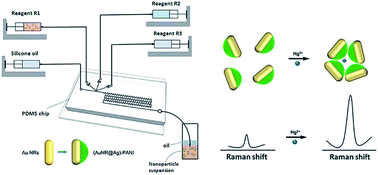Droplet-based microfluidic synthesis of (Au nanorod@Ag)–polyaniline Janus nanoparticles and their application as a surface-enhanced Raman scattering nanosensor for mercury detection
Abstract
Metal-conducting polymer hybrid nanoparticles (NPs), due to the synergistic effect of metal NPs and polymers, have attracted significant attention and shown versatile applications. In this work, we proposed a simple and quick method for the synthesis of (Au nanorod (NR)@Ag)–polyaniline (PANI) Janus nanoparticles (JNPs) with the use of a droplet-based microfluidic platform. Precise control of droplet volumes and reliable manipulation of individual droplets during synthesis enabled the (AuNR@Ag)–PANI JNPs to possess excellent dispersion and uniform size. Moreover, the reaction time for the fabrication of the (AuNR@Ag)–PANI JNPs was largely shortened with such a microfluidic platform. The application of the prepared (AuNR@Ag)–PANI JNPs, which can act as a surface enhanced Raman scattering (SERS) sensor, for the detection of Hg2+ ions with high sensitivity and good selectivity was demonstrated. This SERS nanosensor displayed a fairly good response to Hg2+ ions over other possible interfering metal cations, owing to the strong binding affinity between PANI and Hg2+ ions and causing an increase in the Raman intensity of PANI. A good linear relationship between the Raman intensity increment of PANI and Hg2+ ion concentration was obtained in the range of 1–150 nM, and the detection limit of Hg2+ ion concentration was 0.97 nM. Besides, the (AuNR@Ag)–PANI-based SERS nanosensor was successfully applied to the detection of Hg2+ ions in real water samples. Thus, a facile route for the fabrication of (AuNR@Ag)–PANI JNPs by using a droplet-based microfluidic platform is presented, which have been employed to determine Hg2+ ions in combination with SERS spectroscopy. We envision that such a droplet-based microfluidic synthesis strategy can provide a new insight into the design and fabrication of novel NPs, which may be applied in various fields, such as catalysis, photovoltaics, bioscience, and environmental science.

- This article is part of the themed collection: Analytical Methods Recent HOT articles


 Please wait while we load your content...
Please wait while we load your content...